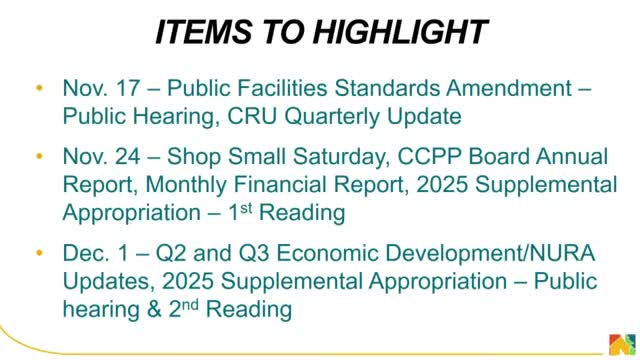Council schedules deeper review of code enforcement priorities amid resident concerns
October 21, 2025 | Northglenn, Adams County, Colorado
This article was created by AI summarizing key points discussed. AI makes mistakes, so for full details and context, please refer to the video of the full meeting. Please report any errors so we can fix them. Report an error »

City Manager Geyer and Mayor Lighty told the council on Oct. 20 that staff will hold an extended, interactive conversation on Dec. 15 focused on code enforcement policy, including the overall philosophy of enforcement, prioritization among violation tiers, and procedural steps from warnings to citations.
Geyer described the item as potentially requiring more than one meeting and said staff planned interactive materials (postcards and posters) so council members could discuss and reorder priorities among the city’s tiered code categories. “This conversation... may require a couple of conversations. It may it's a it's a meaty topic,” Geyer said.
Mayor Laura Lighty and multiple council members urged that the December session focus on clarifying priorities for health-and-safety issues, improving communications to residents, and ensuring consistent, equitable enforcement. Lighty said past tier lists have been confusing and that residents frequently question why some properties are cited while nearby properties that appear similar are not.
Council members raised several recurring concerns: expired vehicle registrations and parking near hydrants or intersections (safety issues), perceived inequities where private properties are cited while adjacent city-owned properties appear in similar condition, and the tone and content of warning letters. Council member Burns asked whether the enforcement program is achieving its stated goals and requested attention to internal culture and customer-service practices for code staff. Council member Kondo requested review of the operational algorithm that determines enforcement responses, observing that opaque internal rules can create frustration for residents.
Several council members noted that anonymous complaints can impede enforcement in certain cases. Kondo recounted a situation in which a complainant’s choice to remain anonymous limited the city’s ability to pursue remedies in a protracted animal-hoarding case. Council members asked staff to review legal and procedural limits on anonymous reporting and to bring forward any options for protecting complainants while enabling effective follow-up.
Council members also requested more data on enforcement (volume of complaints, outcomes, citations, and which tiers generated court referrals) to better assess whether code enforcement is meeting strategic goals. Mayor Lighty suggested health-and-safety violations should be prioritized in any revised tiering system.
Nut graf: The council directed staff to prepare an in-depth, participatory review of code enforcement policies and priorities—focusing on clear tier definitions, equitable application, data transparency and resident communication—so members can provide policy guidance on Dec. 15.
Ending: Staff will return with interactive materials, data on enforcement activity and proposed changes to tier definitions and processes. Councilmembers signaled consensus to schedule the fuller conversation and to avoid trying to compress the agenda into a single short meeting.
Geyer described the item as potentially requiring more than one meeting and said staff planned interactive materials (postcards and posters) so council members could discuss and reorder priorities among the city’s tiered code categories. “This conversation... may require a couple of conversations. It may it's a it's a meaty topic,” Geyer said.
Mayor Laura Lighty and multiple council members urged that the December session focus on clarifying priorities for health-and-safety issues, improving communications to residents, and ensuring consistent, equitable enforcement. Lighty said past tier lists have been confusing and that residents frequently question why some properties are cited while nearby properties that appear similar are not.
Council members raised several recurring concerns: expired vehicle registrations and parking near hydrants or intersections (safety issues), perceived inequities where private properties are cited while adjacent city-owned properties appear in similar condition, and the tone and content of warning letters. Council member Burns asked whether the enforcement program is achieving its stated goals and requested attention to internal culture and customer-service practices for code staff. Council member Kondo requested review of the operational algorithm that determines enforcement responses, observing that opaque internal rules can create frustration for residents.
Several council members noted that anonymous complaints can impede enforcement in certain cases. Kondo recounted a situation in which a complainant’s choice to remain anonymous limited the city’s ability to pursue remedies in a protracted animal-hoarding case. Council members asked staff to review legal and procedural limits on anonymous reporting and to bring forward any options for protecting complainants while enabling effective follow-up.
Council members also requested more data on enforcement (volume of complaints, outcomes, citations, and which tiers generated court referrals) to better assess whether code enforcement is meeting strategic goals. Mayor Lighty suggested health-and-safety violations should be prioritized in any revised tiering system.
Nut graf: The council directed staff to prepare an in-depth, participatory review of code enforcement policies and priorities—focusing on clear tier definitions, equitable application, data transparency and resident communication—so members can provide policy guidance on Dec. 15.
Ending: Staff will return with interactive materials, data on enforcement activity and proposed changes to tier definitions and processes. Councilmembers signaled consensus to schedule the fuller conversation and to avoid trying to compress the agenda into a single short meeting.
View full meeting
This article is based on a recent meeting—watch the full video and explore the complete transcript for deeper insights into the discussion.
View full meeting
